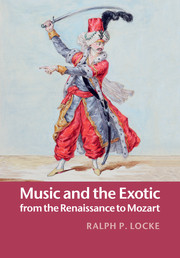Book contents
- Music and the Exotic from the Renaissance to Mozart
- Music and the Exotic from the Renaissance to Mozart
- Copyright page
- Dedication
- Contents
- Figures
- Music examples
- Book part
- Notes to the reader
- Part I Introduction: a rich and complex heritage
- Part II The West and its Others
- Part III Songs and dance-types
- Part IV Exotic portrayals on stage, in concert, in church
- Afterword: A helpfully troubling term
- Notes
- Bibliography
- Index
- References
Bibliography
Published online by Cambridge University Press: 05 May 2015
- Music and the Exotic from the Renaissance to Mozart
- Music and the Exotic from the Renaissance to Mozart
- Copyright page
- Dedication
- Contents
- Figures
- Music examples
- Book part
- Notes to the reader
- Part I Introduction: a rich and complex heritage
- Part II The West and its Others
- Part III Songs and dance-types
- Part IV Exotic portrayals on stage, in concert, in church
- Afterword: A helpfully troubling term
- Notes
- Bibliography
- Index
- References
- Type
- Chapter
- Information
- Music and the Exotic from the Renaissance to Mozart , pp. 394 - 444Publisher: Cambridge University PressPrint publication year: 2015



